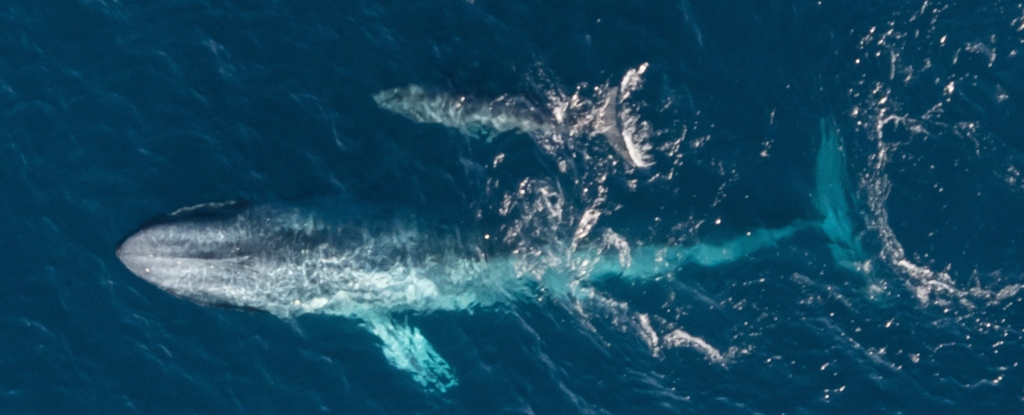Scientists have sighted what could be the youngest pygmy blue whale (Balaenoptera musculus brevicauda) ever seen in Australian waters.
The calf was photographed by spotter pilot Tiffany Klein who was flying over the tropical waters offshore Ningaloo, in Australia’s northwest, to satellite tag the pygmy blue whales for a joint research project between the Australian Institute of Marine Science (AIMS) and the Centre for Whale Research.
The researchers hope to find out more about the migratory routes, feeding areas, and reproduction of this potentially endangered subspecies of blue whale about which little is known.
These whales pass through the warm waters of Ningaloo on their northward migration from the Perth canyon in south-west Western Australia, through the tropics at Australia’s northwest tip, eventually reaching the Banda Sea near eastern Indonesia via the waters of Timor-Leste.
Ever since monitoring began in 1999, cows and young calves have been sighted at the southernmost end of the route, but we’ve never seen any as tiny as the 6–7-meter (around 20–23-foot) baby that Klein spotted off Ningaloo.
“Previously, I’ve seen them later in the year, around September or October, and traveling south,” Klein says.
“These calves were about half the size of their mother, whereas this one was only about a third of the size.”
frameborder=”0″ allow=”accelerometer; autoplay; clipboard-write; encrypted-media; gyroscope; picture-in-picture; web-share” referrerpolicy=”strict-origin-when-cross-origin” allowfullscreen>
The current joint research project, which began in 2019, involves attaching tags to the whales that can be read by satellite, and dive loggers that provide readings on the whale’s movements underwater.
It’s believed these pygmy blue whales separated from their Antarctic blue whale kin (Balaenoptera musculus intermedia) around 20,000 years ago, when they were pushed northward by expanding sea ice during the last glacial maximum.
Even when the ice receded, this small group remained in their new antipodean home, which is the main reason for their distinct lineage and low genetic diversity.
“No one really knows where pygmy blue whales calve, but here in the Indian Ocean, they are thought to breed and calve at the end of their northward migration off Western Australia’s coast and in Indonesian waters,” says ecologist Michele Thums from AIMS, who led the project.
And yet, the size of the calf spotted in Australian waters and its proximity to Ningaloo suggest it was born closer to key feeding grounds in the Perth Canyon, which is the southern end of their migratory route.
“Some experts think they may give birth, or calve, soon after leaving their foraging grounds, which for this population is the Perth canyon,” Thums says, adding, “having consulted with other experts in [the northern migration] region, a calf of this size is not something that’s been observed before by any of them.”
Recent sightings at the northern end of these elusive whales’ migratory route, in Timor Leste, have also shed light on the secret lives of these gentle giants.
frameborder=”0″ allow=”accelerometer; autoplay; clipboard-write; encrypted-media; gyroscope; picture-in-picture; web-share” referrerpolicy=”strict-origin-when-cross-origin” allowfullscreen>
Footage captured as part of a decade-long project led by Australian National University marine ecologist Karen Edyvane reveals a mother nursing her young and a pair of adults mating.
“Our decade-long project has documented some of the lesser-known intimate reproductive behaviors of blue whales, some for the very first time. It’s very exciting,” Edyvane says.
This evidence, the researchers say, suggests the top end of the whales’ migration is also a critical site for reproduction.

